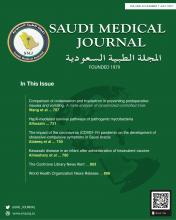To the Editor
In their study titled “the correlation between fear of falling and upper extremity muscle strength” published in the Saudi Medical Journal, April 2021, Dr. Yardimci et al1 studied the relationship between fear of falling (FOF) and upper extremity muscle strength. This single-center, cross-sectional study lacked longitudinal follow-up; hence, it is difficult to make generalized conclusions. The authors also acknowledged that the data are observational due to the study’s cross-sectional design; therefore, they could not establish a cause-and-effect relationship.1
The study excluded patients confined to bed. It is unclear why the authors excluded these patients, as such patients could have a high FOF, consequently limiting their activities to bed. Similarly, other musculoskeletal diagnoses affect upper extremity strength and function. Examples include hand osteoarthritis, shoulder impingement syndrome, and rheumatological or degenerative bone and joint diseases.2-4 These are not mentioned in the exclusion criteria and could potentially lead to a selection bias.
The Geriatric Depression Scale is validated for the elderly population,5 so it may not be applicable in a population <65 years. The study by Dr. Yardmici et al1 included patients ranging from 43 to 97 years of age. Additionally, elderly people >75 years of age have an increased risk of low handgrip strength6 and may also have balance-related problems. This could potentially affect the interpretation of the results. Moreover, the population, being nursing home residents, would have practical limitations in relation to the Falls Efficacy Scale (FES) (for example, cleaning the house, going to the shop). These activities may not be relevant to nursing home residents, as most of their daily activities/tasks will be facilitated. Also, nursing homes have other practical limitations for conducting the Lawton-Brody Instrumental Activities of Daily Living (iADL) scale, as it includes categories like shopping and laundry, which may not be applicable to nursing homes.
This study included a population with severe cognitive impairment, since the median ± SD of the Mini-Mental State Examination (MMSE) was 13.6 ± 5.8. Again, this further limits the application of FES, as it has been studied for a population with mild/moderate cognitive impairment (MMSE scores of 17-23), and patients with severe cognitive impairment have shown severe limitations in comparable data acquisition by questionnaires.7
Yardimci et al1 found variation between right- and left-handgrips for the cut-off values in those without a falling risk. It is interesting to note that the authors did not investigate a correlation between handgrip/key pinch strength and hand dominance in the study population. Handedness and grip strength are well documented in the literature; however, Bohannon8 found that grip strength is typically greater on the dominant than on the nondominant side, but the difference between sides varies widely among studies and depends on whether individuals are right- or left-hand dominant.
The authors used a 6-meter up-and-go test to determine lower extremity strength. However, the only similar test is the Timed Up and Go test (TUG), which differs in the unit used to calculate time calculation, since TUG calculates the time in seconds, while the authors calculated time in minutes for the 6-meter up-and-go test. The TUG test is a reliable and validated test for quantifying functional mobility and screening balance deficits that lead to increased fall risk, but it has limited ability to predict falls.9,10 Timed Up and Go test is not usually used to determine lower extremity strength. Other tests, like the Five Times Sit-To-Stand test, could better quantify functional lower extremity strength.11 Similarly, for fall risk assessment, the Morse Fall Scale (MFS) would give a more direct and valid assessment of fall risk.12
Finally, the authors stated, “we have concluded that FOF increases with decreased muscle strength,” but it is difficult to justify because no baseline measurement of hand strength or fear of fall assessment was carried out.
Reply from the Author
Our research’s aim was to study the correlation between upper extremity muscle strength and fear of falling. In our paper, we have used tools that are acknowledged and proven reliable in Europe. As the study was carried out in a nursing home, number of participants were accordingly. Our data and statistics show us that upper extremity strength and fear of falling are correlated. We believe that this study can be a pioneer of oncoming studies that are trying to find correlations between physical capabilities of elderly patients and fear of falling.
Bulent Yardimci
Istanbul American Hospital Istanbul, Turkey
ORCID ID: https://orcid.org/0000-0002-0364-8238
- Copyright: © Saudi Medical Journal
This is an Open Access journal and articles published are distributed under the terms of the Creative Commons Attribution-NonCommercial License (CC BY-NC). Readers may copy, distribute, and display the work for non-commercial purposes with the proper citation of the original work.






